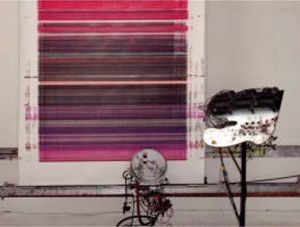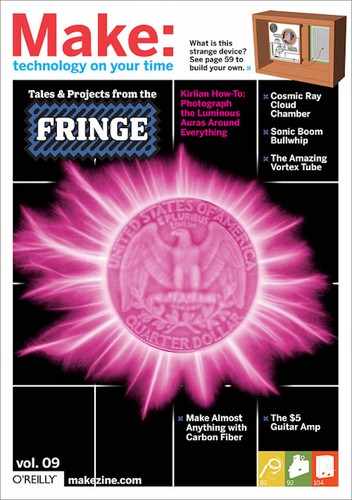ART WORK
The Joy of YDKEWYGUYGI
LIKE MOST TECHNOLOGIES, MANY EARLY mark-making machines were purely practical, usually addressing the pre-printing-press need for quick and easy copying. The automaton craze of the 18th century produced the first completely mechanical drawing and writing machines, as well as some of the first machines with mechanisms that were as interesting as their outputs. (And sometimes more so!)
Swiss inventor Henri Maillardet made a machine that could produce four different drawings and three poems encoded on a large set of complex cams. It signed its own work by writing “Ecrit par L’Automate de Maillardet” (“Written by Maillardet’s Automaton”) in the border of the final poem — perhaps evidence that even the earliest mark-making machine makers were playing with questions of authorship and intention. Maillardet’s automaton is on display at the Franklin Institute. It still works!
You might think that advances in printing technology would have meant the end of homemade mark-making machine mania, but they haven’t. Although inkjet and laser printers do a great job of creating clean copies of full-color text and images, they’re not so great at doing some of the things that make manual mark-making so interesting.
Sure, you can simulate brush strokes in your digital painting program, but making real brush strokes is more fun. While untold thousands of engineering hours have gone into making sure that WYSIWYG when you send a job to your printer, there’s still a lot of interest in systems where you don’t know exactly what you’ll get until you’ve got it (YDKEWYGUYGI).
Jean Tinguely, a 20th-century Swiss artist, is best known for his large kinetic sculptures made from scavenged industrial debris. Starting in the late 1950s, Tinguely made a series of “Méta-matic” drawing machines, complex jumbles of gears, springs, and weights. The unpredictability of the mechanism coupled with the choices made by the user (selecting different kinds of papers and brushes or making adjustments to the mechanism itself) assures that no two runs of the machine are alike. This is a theme that, ironically, appears often in machine-made art: non-repeatability and the potential (and pitfalls) of infinite variety. If you’re ever in Basel, make sure to check out the Tinguely Museum — there’s even a working Méta-matic that you can play with for €1.
In the late 1970s, Croatian-American artist Anton Perich built a large, light-controlled painting machine from cobbled-together parts of sewing machines and industrial debris he found on Canal Street in Manhattan. There’s a telling quote in The
“Anton was home with his painting machine and I was so jealous. My dream. To have a machine that could paint while you’re away.” —Andy Warhol
Andy Warhol Diaries about Perich’s machine (they were neighbors): “Anton was home with his painting machine and I was so jealous. My dream. To have a machine that could paint while you’re away. But they said he had to be there while it painted because it clogs up.”
Warhol was being wry here, but he brought up a common misconception; the motivations of mark-making machine makers are generally more complex and interesting than “I want a machine to do my work for me.” For some artists, the output of the machine isn’t even the main point; the process or method of making marks can sometimes be as, or even more, interesting than the marks themselves. As for Perich, 30+ years later he’s still making big, complex paintings with his original machine.
Sabrina Raaf’s “Grower” and Fernando Orellana’s “Drawing Machine 3.1415926 v.2” are two machines that make marks that would be impossible for humans to make on their own, and both make nods toward early analog scientific recording equipment.
Raaf’s machine is a robot that draws green marks (evoking blades of grass) on a wall, the heights of which correspond to the amount of CO2 in the air. Over the days and weeks that the robot is working, it builds up a field of data-driven “grass” as it tirelessly treks back and forth along the wall.
Orellana’s machine is a lot like a mobile with a pen attached to it. But rather than just twirling in the wind, the pen’s position on the canvas is controlled by the local ambient sound, similar to the way a seismograph pen records shock waves moving through the Earth. Both works create a long-term record of their local environment, but in a highly stylized form meant to leave an impression, rather than an exact accounting of some environmental variable.
Hektor, a “graffiti output device” by Swiss artists Jürg Lehni and Uli Franke, uses a deceptively simple and elegant mechanism in a small, portable package. Two motors are attached to a wall with a belt hanging between them. A spray paint can and activator hang from the belt, and as the motors turn they pull the spray can around the canvas. Because the mechanism can bring the spray can to any point, the content of the paintings is separate from the machine’s mechanism, making Hektor the equivalent of an enormous general purpose plotter (it’s even driven by Adobe Illustrator). The catch is that despite its elegant design and vector-based data, Hektor’s fuzzy, dripping output is far from pristine. It’s another take on the tension between computer-based precision and real-world grunge.
Some people make machines with outputs that are simply expressions of their own construction (Jonah Brucker-Cohen’s simple plastic-cup-andmotor “drawbots” are a good example of this). Others focus on environmental inputs, or algorithmic control, or AI, or … well, the list goes on. Finally, some people just want to make a machine that makes pretty pictures. There’s room for everyone in the world of mark-making art machines. What’s yours going to do?

Hektor enjoys painting both landscapes and portraits.

Orellana’s Drawing Machine and Raaf’s Grower sense the world and then leave their marks.

Perich’s steampunk painter is half airbrush, half sewing machine.
Photography by (clockwise from top): Jürg Lehni (Hektor); Sabrina Raaf (Grower); Anton Perich (machine at bottom); Fernando Orellana (machine at middle left)
Douglas Irving Repetto is an artist and teacher involved in a number of art/community groups including dorkbot, ArtBots, organizm, and music-dsp.
